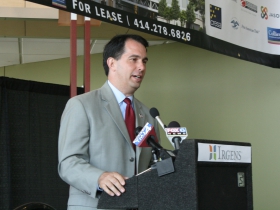Most of Walker’s Support from Outside Wisconsin
Just 46% of his campaign donations from Wisconsin residents versus 73% for Burke.
Two weeks before the July 21 deadline for filing campaign finance reports, the campaigns of Mary Burke, the likely Democratic candidate for governor, and Scott Walker, the Republican incumbent, issued press releases projecting some key numbers.
These figures were nearly the same as those in the actual reports, filed on the due date with the state Government Accountability Board.
They show that Burke’s campaign raised $3.6 million in the first half of 2014, bringing the total since her campaign launch in early October to $5.4 million. She reported having $2.6 million cash on hand.
Walker’s campaign, meanwhile, raised $8.3 million during this same six-month period, leaving him with $7.6 million cash on hand.
Beyond these totals, the filings contain other useful and enlightening information.
A data analysis reveals that Walker has raised nearly $4.6 million so far in 2014, or 55 percent of his total, from people who live in other states. That compares to Burke’s out-of-state total of $1.2 million, or 34 percent of her receipts this year.
Since Burke declared her candidacy last fall, she’s gotten $1.5 million from out-of-state, or 27 percent of her total. Walker, during this same time frame, raised $6.4 million from people in other states, or 54 percent of his total.
Walker’s out-of-state support during this period was led by California, Illinois, Texas and Florida, each accounting for about 6 percent of his total. Burke’s top non-state backing came from California (4.7 percent), the District of Columbia (3.7 percent) and New York (3.1 percent).
The reports also track how much of the candidates’ support comes from big-money donors. Of the $11.9 million that Walker has raised since Burke entered the race, $6.1 million has come from individual contributions of $1,000 or more. Burke has gotten $1.9 million in such donations.
Since the race began, Walker has received 171 individual contributions of $10,000, the maximum. Burke has 56 of these. Additional donors have given the maximum through multiple donations; for instance, former Gov. Jim Doyle and wife Jessica each gave Burke two $5,000 donations.
Burke, a millionaire former Trek Bicycle executive, has given $430,000 to her own campaign. Nearly all of this self-help occurred last year.
Burke spokesman Joe Zepecki said she had no need to further tap her personal resources at this juncture “due to the overwhelming support” she’s received. Joe Fadness, executive director of the Republican Party of Wisconsin, applied a different spin: “Either Burke doesn’t have the personal resources she promised to utilize or she isn’t willing to make an investment in her losing venture.”
Walker has not made any self-contributions to his campaign.
State Rep. Brett Hulsey, D-Madison, Burke’s challenger in the Aug. 12 primary, reported raising $2,488, almost all from himself.
Burke, in an interview with the Wisconsin Center for Investigative Journalism this spring, said she knew she would be outspent but believed she could remain competitive, by spending wisely.
“I will be very targeted in terms of getting my message out, making sure I reach the voters who haven’t made up their minds,” she said.
The latest Marquette Law School poll, released July 23, found that Burke and Walker were in a “dead heat,” with Walker having 46 percent support among registered voters to Burke’s 45 percent. Among likely voters, Burke polled 47 percent to Walker’s 46 percent.
All results were within the poll’s margin of error.
Just 8 percent of respondents said they were undecided. Many millions will be spent courting this relatively small group.
Bill Lueders is the Money and Politics Project director at the Wisconsin Center for Investigative Journalism (www.WisconsinWatch.org). The Center produces the project in partnership with MapLight.
The Center collaborates with Wisconsin Public Radio, Wisconsin Public Television, other news media and the UW-Madison School of Journalism and Mass Communication. All works created, published, posted or disseminated by the Center do not necessarily reflect the views or opinions of UW-Madison or any of its affiliates.























So because I’m horrific at math and I don’t have the raw data, how do the two compare on just in-state contributions for totals?
And because I’m even more of a dork on this, how do these numbers compare to this point in ’12 or ’10? If she got more in-state than Barrett during those times and Walker got less in state compared to those times, that could be a really interesting stat.
“In the 2010 governor’s race, Walker raised just 7 percent of his funds from outside of Wisconsin, compared with 13 percent for Barrett, according to the National Institute on Money in State Politics.”
-In 2012:
Candidate Total raised Pct. from out of state
Walker $25.3 million 57 percent
Falk $993,845 48 percent
Barrett $831,510 13 percent
LaFollette $118,088 3 percent
Vinehout $93,999 10 percent
http://www.politifact.com/wisconsin/article/2012/may/22/behind-rhetoric-state-out-state-money-debate/
Beer Baron, to answer your question… In 2014, Walker raised more in-state funds (3.7 million) than Burke did with both in-state (2.4 million) and out of state (1.1 million) combined.
What about percentages, not total dollar amounts? Then who raised more in-state funds?
Doh nevermind. I wish there was an edit option.
And Walker’s ~$5M overage of Out-of-State contributions “pale” in Comparison to the likely TENS of MILLIONS that organized labor has said that they will target at Walker’s re-election run this Fall. So typical of UM to “conveniently” omit this key detail in their blaring headline and follow-on figures. And here’s the proof that this number of “OUT OF STATE / CONSCRIPTED MONEY FROM UNION WORKERS” will be spent on the lowly Wisconsin Gubernatorial election:
http://watchdog.org/129731/elections-unions-republicans/
Smoke that one!